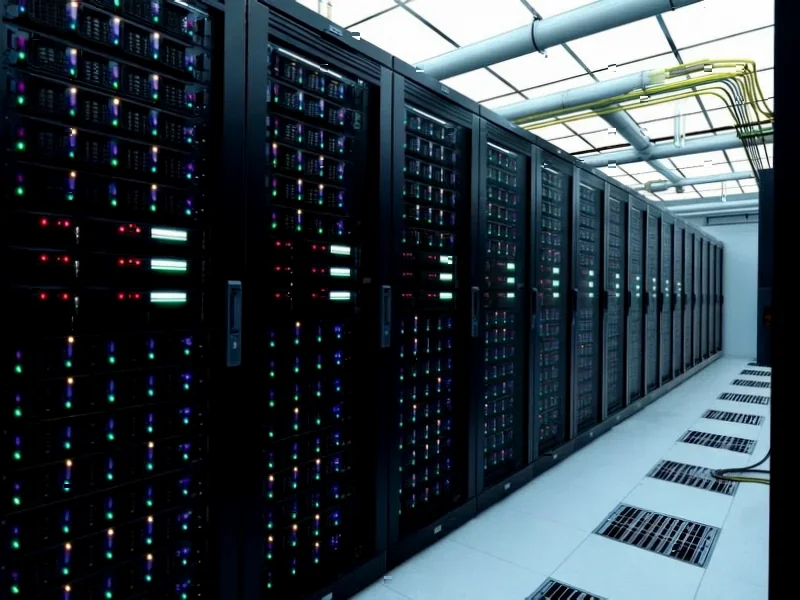According to GSM Arena, OpenAI has announced a strategic partnership with Amazon Web Services that will enable ChatGPT to run on AWS infrastructure effective immediately. The seven-year deal represents a $38 billion commitment and will deploy Amazon EC2 UltraServers featuring hundreds of thousands of Nvidia GPUs with scaling capacity to tens of millions of CPUs. All AWS capacity under this agreement will be deployed before the end of 2026, with an option to expand further from 2027 onward. The architecture specifically clusters Nvidia GB200 and GB300 GPUs on the same network for low-latency performance across interconnected systems, according to the company’s announcement. This massive infrastructure investment signals a fundamental shift in how AI companies approach computational scaling.
The UltraServer Architecture Explained
Amazon EC2 UltraServers represent AWS’s most advanced computational infrastructure specifically engineered for massive-scale AI workloads. What makes this architecture particularly compelling for OpenAI’s needs is the clustering of Nvidia’s latest GB200 and GB300 GPUs on unified networking fabrics. This isn’t simply about adding more GPUs—it’s about creating tightly-coupled computational meshes where thousands of GPUs can communicate with minimal latency. The GB200 series, built on Nvidia’s Blackwell architecture, features significant improvements in memory bandwidth and tensor core performance specifically optimized for transformer models like GPT-4 and beyond. By colocating these GPUs on the same network backbone, AWS enables model parallelism at unprecedented scale, allowing OpenAI to run single models across hundreds or thousands of GPUs without the communication bottlenecks that typically plague distributed training.
Beyond Raw Compute: The Scaling Challenge
The real technical challenge in AI infrastructure at this scale isn’t just computational power—it’s about maintaining consistent performance across distributed systems. When you’re dealing with “clusters topping 500K chips” as mentioned in the announcement, network topology becomes as critical as GPU specifications. Traditional cloud architectures struggle with the all-to-all communication patterns required by large language model training, where every GPU needs to exchange gradients with every other GPU during each training step. AWS’s solution likely involves custom networking hardware, possibly leveraging their Nitro system architecture combined with specialized interconnects that can handle the massive bisection bandwidth requirements. This explains why the deployment timeline extends to 2026—building out this level of specialized infrastructure requires significant physical data center construction and networking deployment beyond standard cloud capacity.
The Multi-Cloud Strategy Reality
What’s particularly revealing about this deal is what it says about OpenAI’s relationship with Microsoft Azure. Despite Microsoft’s $13 billion investment in OpenAI and their existing Azure partnership, this $38 billion AWS commitment demonstrates that even the closest AI partnerships can’t meet all computational demands. The reality of modern AI infrastructure is that no single cloud provider can offer everything an organization like OpenAI needs at the scale they require. This creates a fascinating dynamic where OpenAI maintains strategic partnerships with competing cloud providers, essentially playing them against each other for pricing and capability advantages. The seven-year term suggests OpenAI is hedging against potential capacity constraints or pricing disputes with any single provider, ensuring they have multiple paths to scale their computational requirements as model sizes continue to grow exponentially.
Low-Latency Networking: The Unsung Hero
The emphasis on “low-latency performance across interconnected systems” points to one of the most technically challenging aspects of large-scale AI training: reducing communication overhead. When training models with trillions of parameters, the time spent synchronizing gradients between GPUs can dominate the total training time. AWS’s architecture likely employs specialized networking technologies like their Elastic Fabric Adapter (EFA) or possibly even custom silicon designed specifically for AI workload communication patterns. The clustering of GB200 and GB300 GPUs on the same network suggests a hierarchical architecture where GPUs within a cluster communicate through ultra-low-latency interconnects, while clusters communicate through higher-latency but higher-bandwidth connections. This hybrid approach balances the need for fast local communication with the practical realities of building at massive scale.
Infrastructure as Competitive Advantage
This deal fundamentally changes the competitive landscape for AI infrastructure. At $38 billion over seven years, we’re looking at approximately $5.4 billion annually in committed spending—more than many tech companies’ entire R&D budgets. This level of investment creates an almost insurmountable barrier to entry for competitors and positions infrastructure access as a primary competitive differentiator in the AI race. The timing is also significant—with full deployment scheduled by end of 2026, OpenAI is essentially locking in capacity for their next 2-3 generations of models. Given the exponential growth in model size and training requirements, this forward-looking infrastructure planning may prove to be as strategically important as their algorithmic innovations. The option to expand from 2027 suggests OpenAI anticipates even greater computational demands as they progress toward artificial general intelligence.




